Given the recent unrest in Baltimore and Ferguson, Black Then felt it fitting to publish a list of American race riots that resulted in terrible loss of life. These aren’t necessarily the ten deadliest riots, but they represent a cross-section of American history — the history of a nation “dedicated to the proposition that all men are created equal.”
8. The Battle of Hayes Pond (1958)
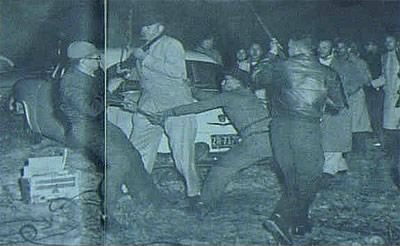
In 1956, the Lumbee Indians of Robeson County, North Carolina achieved official recognition, and this infuriated a local Ku Klux Klan leader, James Cole. Within a year, Cole, who also fancied himself a preacher, was denouncing the Lumbee Indians as half-breeds with African origins. Crosses were burned on Lumbee lawns in an effort to scare the Lumbee citizens into silence, but it didn’t work.
Cole planned a rally on a path of secluded farmland on the night of January 18, 1958. The local sheriff warned him to stay away for his own safety, but about 50 to 100 armed Klansmen arrived for the purpose of burning a cross. Before Cole could begin denouncing the Lumbee, 500 Lumbee Indians showed up with their own firearms and shot out the Klan’s spotlight, plunging the whole area into pitch darkness. They then began shouting and firing their weapons into the air. The Klansmen fled the scene, with four being wounded. Cole left his own wife behind and waded through a swamp to get away. He was subsequently prosecuted and served two years in prison for inciting a riot.
7. The Ferguson Riots (2014)
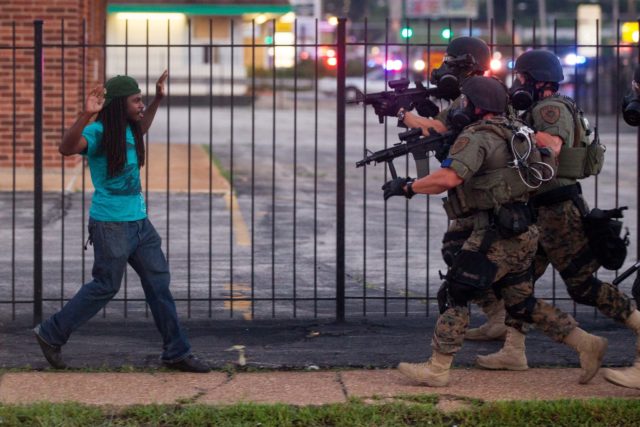
While protests have taken place in cities across the nation, they’re centered on the aftermath of a police shooting that occurred in Ferguson, Missouri on August 9, 2014. Much information and misinformation has circulated regarding the nature of the shooting, and whether Michael Brown had his hands up and was surrendering or whether he was charging Sgt. Darren Wilson. All that’s agreed on is that Brown had just shoplifted cigars from a convenience store and was obstructing traffic when Sgt. Wilson confronted him and a friend.
But the entire Ferguson area had been a racial tinderbox for years, and when eyewitnesses reported that Brown was unarmed and shot dead from behind, the city exploded in protest. Most of it took the form of peaceful marching and civilly disobedient rallies, but there was also widespread looting, vandalism and arson in the neighborhoods around Brown’s family’s home.
Then, on November 24, the Ferguson grand jury concluded that no charges should be filed against Sgt. Wilson. Within minutes, Ferguson erupted a second time. This outbreak of violence was worse, with 12 buildings and two police cars set on fire. Firefighters couldn’t respond to some cases because they began taking gunfire from rioters. The store Michael Brown had robbed before his encounter with Wilson was vandalized and looted in apparent retaliation against the verdict. Protests and small-scale riots broke out elsewhere across the nation as well — a total of 205 people have been arrested as of November 30, 2014.
6. The Wilmington Insurrection (1898)
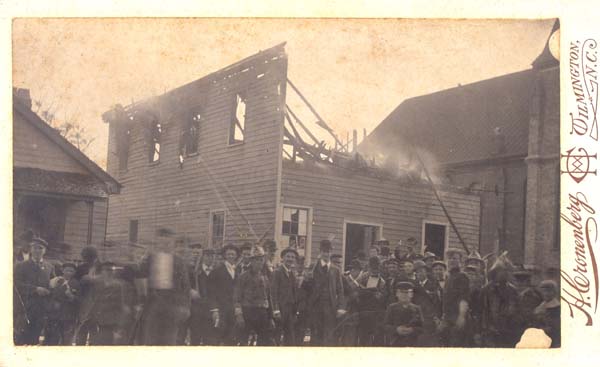
North Carolina had long been a hotbed of racial unrest. In 1898, only 35 years after blacks got the right to vote, many of the whites in the area openly hated them and did not choose their words carefully when expressing this. The Republican Party was biracial, but the Democratic Party ran an 1898 campaign of regaining white supremacy. The Democrats regained control of the state legislature, and the some whites in Wilmington formed a group of 25 who demanded that Alexander Manly, a black newspaper owner, be forced to shut down and leave. Manly refused, whereupon Alfred Waddell, a white supremacist and Congressman who had just been unseated, organized a group of 2,000 armed white Spanish-American War veterans who marched to the newspaper office. They destroyed the printing equipment and burned the building to the ground.
Waddell intended to disband the group, as the job was done and Manly had gone into hiding. But the mob quickly turned anarchic, and began hunting down and attacking blacks all over the city. Violence continued for several days. Death estimates range from six to 100, all blacks, with the wide range due to the incomplete records of the hospitals. Many blacks fled the city and hid in the swamps, while others left the area permanently. Waddell was subsequently “elected” mayor, essentially as a result of a coup d’etat.
5. The Detroit Race Riot (1943)
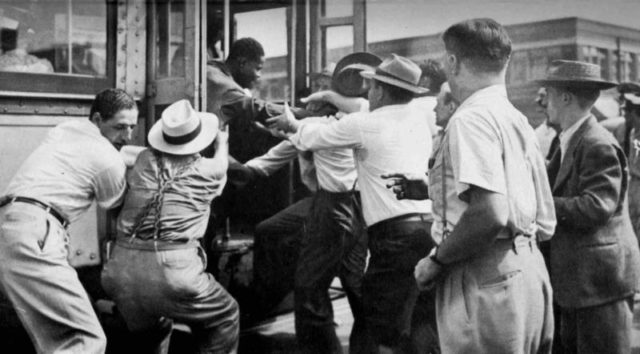
This riot had been brewing for years in an area with a history of discrimination against blacks. When automobile factories, which were working at maximum speed and capacity because of the war, began hiring blacks to work alongside whites on the factory floors, the white workers responded by walking off the job. During a pro-white rally in June 1943, about three weeks before the riot, a voice was heard over a loudspeaker saying, “I’d rather see Hitler and Hirohito win than work next to a nigger!”
The riot began with a fistfight between a white sailor and a black man who was thought to have insulted the sailor’s girlfriend. Other fights had already broke out, but this was the tipping point that turned into a community-wide brawl. False rumors went up that white men had thrown a black mother and baby into the river, and that blacks had raped and murdered a white woman. The rioting lasted for three days, peaking as masses of angry whites beat up black motorists and pedestrians, and angry blacks responding in kind. 34 people were killed, 433 were injured and $2 million worth of property was damaged. The riots didn’t abate until Franklin Roosevelt sent Federal troops into the city.
4. The Watts Riots (1965)
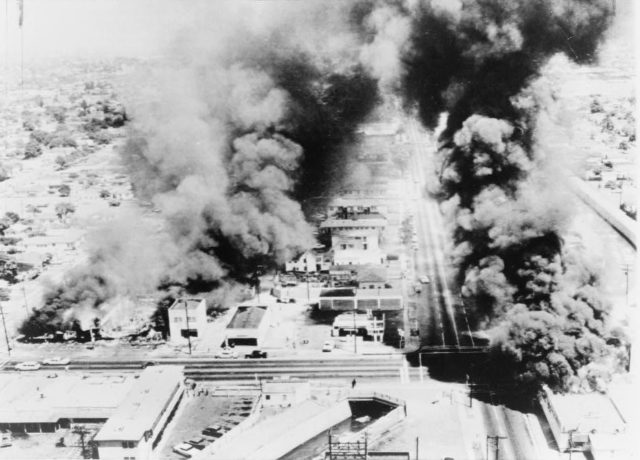
This period of unrest in Los Angeles was preceded by years of racial tension. The city had become a powder keg, and the riot began with a traffic stop on August 11. A 21 year-old black man named Marquette Frye was pulled over for reckless driving and was given a field sobriety test. His brother and passenger, Ronald, walked to their nearby home and brought back their mother, Lena Price, who began to lecture her son for drunk driving. What happened next is unclear, but an altercation began between all three black people and the white police officers, with Price jumping on one of the officers and an officer pulling out a shotgun. No shots were fired, but all three civilians were arrested and a false rumor began that the police had kicked a pregnant woman.
3. Nationwide Rioting after Martin L. King, Jr.’s Death (1968)
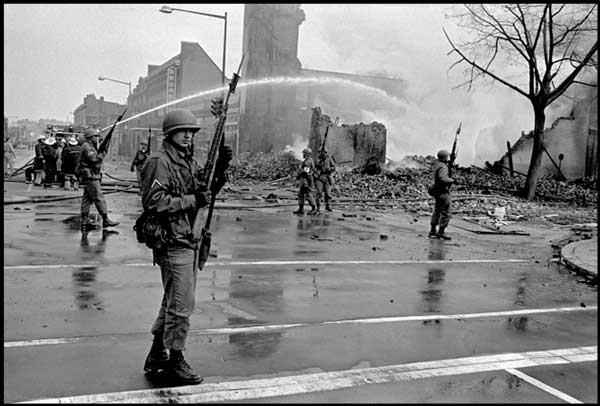
It’s painfully ironic that King was a staunch advocate of nonviolent protests, and yet despite his family’s repeated pleas for nonviolence, militant blacks like Stokely Carmichael openly called for blacks to acquire guns and retaliate against King’s assassination. Most demonstrations around the nation were peaceful, but 110 cities suffered from various degrees of anarchy, especially Washington, D. C.
Carmichael led protesters past stores that he demanded should close out of respect. It didn’t take long for the crowd to lose its temper and start throwing bricks through windows. Looting became widespread. On the morning of the second day, Carmichael made a show of calling for nonviolence but kept speaking about that fact that something had to be done, and the crowd took this as a call to arms. They began marching en masse down the streets, confronting and fighting the police and setting fire to buildings. Firefighters were pelted away with rocks and bottles, and the 3,100-strong police force was overwhelmed by crowds numbering up to 20,000.
Lyndon Johnson assigned 13,600 federal troops to guard the city and restore order. The rioters came within two blocks of the White House but retreated when they saw heavy machine guns. This was the largest military occupation of an American city since the Civil War. 1200 buildings were burned to the ground, destroying downtown Washington’s economy. Buildings reduced to rubble were left squalid for years. 12 people were killed, over 1,000 were injured, and over 6,000 were arrested.
2. The Red Summer (1919)
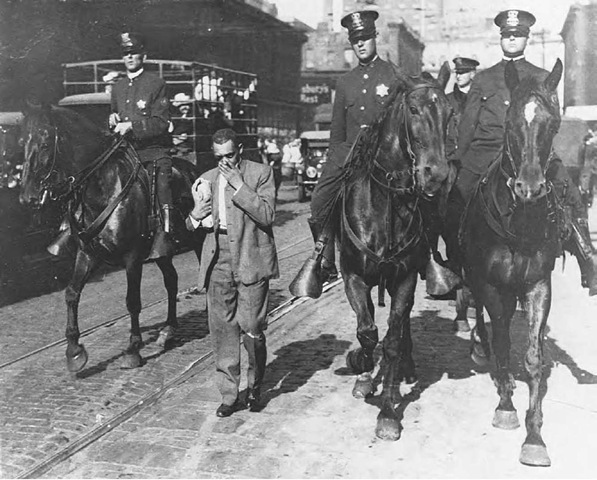
This was a nationwide uprising of whites against blacks during the demobilization that followed WWI. More than 36 cities suffered large-scale unrest and destruction, and black populations fought back most strongly in Washington, D. C. and Chicago. The tension was caused by the labor shortage in industrial cities of the North, since so many men had gone to Europe to fight. Poor black people migrated north from Southern states looking for jobs, and the local whites didn’t want to work with them. From January 1 to September 14, 1919, 38 riots were documented across the nation and at least 43 blacks were lynched by white mobs, while 11 black men were literally burned at the stake.
The first major riot occurred in Charleston, South Carolina on May 10, led by Navy sailors who incited a mob to kill three black men. In July there were riots in Longview, Texas, and Bisbess, Arizona, and during the latter the white police force attacked the veterans of a black cavalry regiment without provocation. The riots in Washington began in July after a black man was arrested for rape. White mobs formed and rampaged through the city for four days, beating black people, pulling them off streetcars and mugging them at random. The police stood by and watched, so the black population decided to defend itself. 10 whites and five blacks were killed.
The worst of the violence occurred in Chicago. It remains the worst race riot in Illinois history, with 23 blacks and 15 whites killed. The riot started with a white man heaving rocks at random black people swimming in Lake Michigan. He killed a black man named Eugene Williams, but when a police officer arrived he arrested a black man who had nothing to do with it. The blacks and whites exploded against each other and the rioting spread throughout the city, driven primarily by mobs of angry whites who openly invaded and attacked black people. Steel cables were thrown across streets to prevent fire trucks from entering, and 1,000 people, most of them black, were left homeless due to arson. 17 blacks were indicted by grand juries, while no whites were convicted of anything.
1. The Rodney King Riots (1992)
This incident was borne out of a long-standing and deep-seated enmity between the black population of Los Angeles and the perceived majority-white LAPD. The riots began not after the publication of the famous recording of Rodney King’s beating at the hands of white police, but after the trial of the four officers responsible led to them being acquitted of all charges. Rioting began and wouldn’t stop for almost a week, when not only the National Guard but also the Army and Marine Corps were forced to intervene.
The LAPD is the third largest police force in the United States, and yet they found themselves powerless to stop the citywide looting, arson, and general mayhem. The most notorious incidents were two gang beatings of innocent motorists on the first day. A group of six black men dragged Reginald Denny, a white man, from his 18-wheeler and beat him nearly to death. Denny’s skull had been fractured in 91 places, his left eye had been knocked into his sinus cavity and a chunk of concrete hurled into his temple caused a seizure. He was rescued by several civilians, one of them a black man named Bobby Green who drove him to the hospital.
Another motorist, Fidel Lopez, was dragged from his vehicle by the same men, robbed and beaten nearly to death before being saved by a local ex-convict preacher, Bennie Newton. Newton shoved his way through the gang, covered Lopez’s body and held up a Bible, shouting, “Kill him and you’ll have to kill me, too!” The gang backed off.
The black population began looting on a massive scale, especially in Koreatown in apparent retaliation for a Korean civilian’s shooting of a black girl one year earlier. Korean business owners began defending themselves with assault rifles, shotguns, handguns and molotov cocktails, and an open gun battle took place in the streets that the police did very little to stop. Firemen had to respond to the widespread arson by being escorted by heavily armed police. Rodney King himself took the news and famously stated, “Can we all get along?”
By the third day, George H. W. Bush sent in the Army and Marines, boosting the military presence to 13,500 troops. It was this show of force which finally curtailed the anarchy, but it wasn’t until the sixth day that the riot was pronounced over. 53 people had been killed, over 2,000 injured, and over 11,000 arrested. Property damage was estimated at over $1 billion, making it the largest scale American riot since the 1960s and the one with the second worst death toll.
Source http://www.toptenz.net/10-worst-race-riots-american-history.php







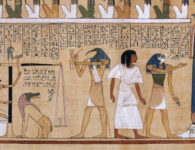
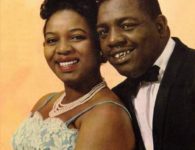
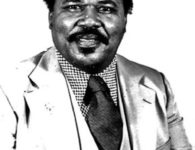
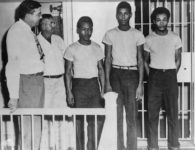
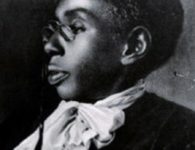

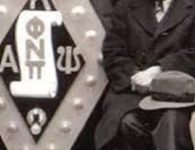
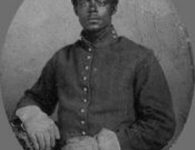
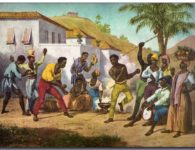
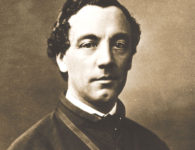
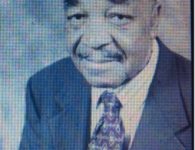
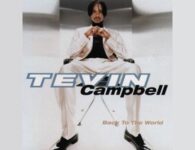

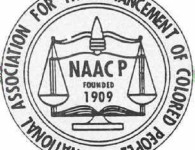
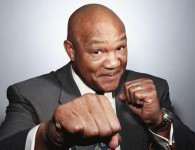

11 Comments
What about the Newark riot of 67 in NJ?
What is not included in this list is the deadliest massacre and riot in American history. That is the East St Louis, IL race riot of 1917.
When some one searches for his essential thing,
thus he/she needs to be available that in detail, thus that thing is maintained over here.
I for all time emailed this website post page to all my contacts, for the reason that if like to
read it afterward my contacts will too.
I’m really enjoying the theme/design of your weblog.
Do you ever run into any web browser compatibility
problems? A number of my blog visitors have complained about my blog not working correctly in Explorer
but looks great in Firefox. Do you have any tips to help fix this issue?
Your style is very unique in comparison to other people I have read stuff from.
I appreciate you for posting when you’ve got the opportunity,
Guess I will just book mark this site.
Good post. Thanks.
Hey There. I found your blog using msn. This is an extremely well written article.
I’ll make sure to bookmark it and come back to read
more of your useful information. Thanks for the post.
I’ll definitely comeback.
?????THE CONCULOID RACE DOESN’T WHITE•WASH THEIR○SINS■?ABOUT THE HATE FOR “REAL•BLACK•HUMANKIND WHILE THE GLOBAL u??s IS WATCHING ???✡?circa:1913-2020
What about the Tulsa Race Riot?
Thanks for sharing this post !!!!